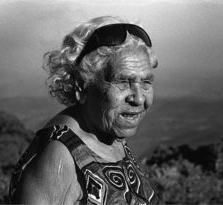Queenie McKenzie facts for kids
Quick facts for kids
Queenie McKenzie
|
|
|---|---|
 |
|
| Born |
Mingmarriya
circa 1915 |
| Died | 16 November 1998 (aged 82–83) Warmun (Turkey Creek), East Kimberley, Western Australia, Australia
|
| Nationality | Australian |
| Other names | Garagarag, Mingmarriya, Queenie Nakarra, Gara-garag |
| Known for | Painting, contemporary Indigenous Australian art |
Queenie McKenzie (also known as Nakarra or Mingmarriya) was an important Aboriginal Australian artist. She was born around 1915 and passed away in 1998. Queenie grew up in the East Kimberley region of Western Australia, a place that deeply inspired her art.
Contents
Growing Up in the Kimberley
Queenie McKenzie's mother was from the Malngin and Gurundji communities. Her father was a white horse-breaker.
When Queenie was young, the government had a policy where many Aboriginal children with mixed heritage were taken from their families. They were often sent to special institutions. However, Queenie's mother protected her by reportedly darkening her skin with charcoal. This helped Queenie stay with her family.
Queenie grew up working with the stockmen on the Texas Downs cattle station. She lived her whole life in the East Kimberley area. She knew the land very well. She once said, "Every rock, every hill, every water, I know that place backwards and forwards, up and down, inside out. It's my country and I got names for every place."
Queenie took two Aboriginal names. One of them, Mingmarriya, comes from the area near Dingo Springs on Texas Downs Station. This is where she lived and painted.
Queenie's Art Career
Queenie McKenzie was helped by the Waringarri Aboriginal Arts Corporation. This group works to make sure Aboriginal art is respected. They also help artists get paid fairly for their work.
One of Queenie's paintings shows the Mistake Creek massacre, a historical event. The National Museum of Australia bought this painting in 2005. For a while, it was not shown because there was some debate about the historical event it showed. But in 2020, the painting was put on display in a new exhibition at the Museum.
Where to See Her Art
You can find Queenie McKenzie's art in major collections. One important place is the Holmes à Court Collection.
How Popular Was Her Art?
Queenie McKenzie's art is still very popular and sought after in Australia. Her paintings have sold for large amounts of money at auctions, sometimes between $8,000 and $92,000. She has also been listed among the top 100 Indigenous artists whose work sells well. In 2014, she was ranked 21st.
Queenie's Legacy
In her later years, Queenie McKenzie was concerned about the future of her community's culture. She hoped that the Texas Downs station, where she grew up, would be returned to her people, the Texas Mob. She passed away before this wish came true.
However, the government of Western Australia recognized her importance. In the year she died, they named her a "State Living Treasure." This title honors people who have made a great contribution to their state.
Queenie McKenzie was also featured on a special CD-ROM called Moorditj-Australian Indigenous Cultural Expressions. This CD-ROM celebrated the culture of Indigenous Australians in Western Australia. Other artists like Sally Morgan and Jimmy Chi were also included.
Queenie McKenzie was an important influence on other artists, such as the Australian ceramic artist Pippin Drysdale.

